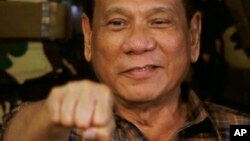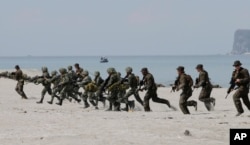Philippine President Rodrigo Duterte is rebalancing his foreign policy away from old ally the United States to former U.S. Cold War foes China and Russia, in a move that may generate a windfall of aid for the developing Southeast Asian country.
Duterte said last month his country would reject U.S. military aid in patrolling the contested South China Sea and fighting a violent Muslim rebel group in his archipelago’s south. The Philippines will cross to “the other side of the ideological barrier,” and work on alliances with China and Russia, the 71-year-old president was quoted telling reporters last week.
China has said it wants talks with Duterte’s government, which took office June 30, to settle a knotty maritime sovereignty issue. Duterte sent an envoy to Hong Kong in August to start making amends. China is likely to provide infrastructure financing for projects the Philippines “so sorely needs,” said Carl Baker, director of programs with the think tank CSIS Pacific Forum.
Beijing has already helped build infrastructure in other poor regions of Southeast Asia, from a pledged $6 billion railway in Laos to Cambodia’s first oil refinery, leading to speculation the Philippines may be next.
“In terms of an economy such as the Philippines, after so many years developing it’s still a question mark over the extent of infrastructure improvement,” said Song Seng Wun, an economist in the private banking unit of CIMB in Singapore. “The Philippine president obviously has seen what Chinese money has done for the Indochinese economy -- Myanmar, Laos, Cambodia in particular.”
Although the president and former mayor of the second-largest Philippine city is known for rash comments, some of which his government has tried to temper, at least some citizens are taking him at face value.
China's value
“China does really good infrastructure and I remember that China was saying it would help the Philippines make infrastructure,” said Valenice Balace, 27, a software technology entrepreneur in metro Manila. “The U.S. has those promises, but I don’t really see it. And in terms of location-wise, we’re a lot closer to China and Russia,” she said. “It’s just kind of scary for me that we’re shifting from the U.S. to ties with China and Russia. In history they were kind of the bad guys.”
Those projects mesh with the mission of the Beijing-spearheaded Asian Infrastructure Investment Bank and the Chinese “One Belt, One Road” strategy of developing other Asian countries, in turn giving contracts to Chinese firms that face slowing economic growth at home. Investments in 49 "One Belt, One Road" countries reached $14.8 billion in 2015.
Duterte said he envisions trade alliances and long-term land leases for China and Russia. Before taking office, the president indicated he might tap China for railway systems in the Philippines during his six-year term.
The Philippines has struggled to win foreign investment partly because of a lack of infrastructure. The seaport in Manila gets congested, brownouts occur in rural areas and internet service is spotty. Last year, the government raised its infrastructure budget to five percent of GDP to build projects that would encourage an inflow of foreign-invested factories.
Russia's value
Russian support for the Philippines could bring defense aid or a stronger position if Duterte negotiates with the United States, analysts believe. Database globalfirepower.com ranks Russia's military as the world's second most powerful after the United States.
Duterte said at an East Asian leadership summit in Laos last month he had asked Russian Prime Minister Dmitry Mevedev for “help in everything, (such as) trade, commerce.”
The president is seeking a more "independent" foreign policy by fanning out diplomacy to China and Russia, Baker said.
US concerns
Duterte has also said the Philippines would stop working with the U.S. Navy in patrolling the disputed South China Sea after two years of joint exercises. He also asked U.S. military advisers last month to leave Mindanao, the southern island where Philippine forces have stepped up a battle against Muslim insurgents since July.
U.S. military advisers have been in Mindanao 14 years, but some Filipinos fear their presence only makes the Muslims angrier and complicates the Philippine government’s campaign. The United States has also irked Duterte by raising questions about his use of extrajudicial killings to fight the drug trade.
Officials in Washington say relations with the Philippines have not effectively changed, but senior lawmakers and a U.S. diplomat raised red flags last week about what follows.
Filipinos largely still support U.S. military help, especially on the South China Sea patrols, said Jay Batongbacal, director of the Institute for Maritime Affairs and Law of the Sea at University of the Philippines.
Duterte’s predecessor, Benigno Aquino, took China to a world arbitration court, which ruled in July that Beijing lacks legal rights to claim 95 percent of the South China Sea, including waters just west of the Philippines.
“[U.S. forces] play a very crucial role right now, especially since the armed forces modernization plans basically have just started,” Batongbacal said. “When it comes to external security operations, I think most Filipinos will want the U.S. to be a co-equal partner.”









